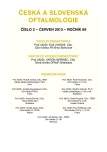HDR 192Ir Brachytherapy in Treatment of Basal Cell Carcinoma of the Lower Eyelid and Inner Angle – our Experience
Authors:
A. Furdová 1; P. Lukačko 2; D. Lederleitner 3
Authors‘ workplace:
Klinika oftalmológie Lekárskej fakulty Univerzity Komenského a Univerzitnej nemocnice, Nemocnica Ružinov, Bratislava, prednosta doc. MUDr. Vladimír Krásnik, PhD.
1; Klinika radiačnej onkológie Onkologický ústav sv. Alžbety a SZÚ, Oddelenie brachyterapie, Bratislava, prednosta
MUDr. Elena Bolješikova, CSc.
2; Oddelenie radiačnej onkológie, pracovisko rádiofyziky, Národný onkologický ústav, Bratislava, primár MUDr. Pobijáková Margita
3
Published in:
Čes. a slov. Oftal., 69, 2013, No. 2, p. 75-79
Category:
Original Article
Časť práce bola prednesená na Vedeckých pracovných dňoch Slovenskej oftalmologickej spoločnosti a sekcie ambulantných lekárov, Košice, 18.-19. máj 2012
Overview
Purpose:
First experience and evaluation of relapses in group of patients after surgery with applied adjuvant HDR brachytherapy for recurrent tumor after incomplete excision of basal cell carcinoma of the lower eyelid and inner angle.
Methods:
Patients with recurrent basal cell carcinoma of the lower eyelid in year 2010. In 3 male patients with recurrent finding of basal cell after surgery we applied adjuvant HDR 192Ir brachytherapy. The isodose curve chosen to prescribe the dose was 5 mm away from the skin surface.
Results:
In the year 2010 we applied adjuvant HDR 192Ir brachytherapy in 3 male patients with recurrent basal cell carcinoma. The average age was 58 years (52 to 75 years).
From group of 41 patients with non melanotic malignant tumors of the eyelids in 3 patients (7.3 %) with relapse after incomplete excision of the basal cell carcinoma of the lower eyelid we applied after removal of stitches after surgery adjuvant HDR 192Ir brachytherapy. For each patient was made individual orfit mask that bore plastic applicators. Tungsten eye shield applicator was applied to protect the eye globe. Treatment of 10 fractions of 4.5 Gy single dose (5 times weekly) were scheduled within 2 weeks. Patients received outpatient treatment.
Conclusion:
Acute toxicity postradiation erythema of eyelid and skin around relieved by standard symptomatic treatment within a few days after completion of radiation therapy.
In 2 year interval after HDR 192Ir brachytherapy we did not record the occurrence of late complications such as corneal ulcers. Our preliminary experience shows excellent early skin tolerance. After 2 years of follow-up at 6 month interval we did not recognize relapse in our group of patients. The proposed technique of HDR 192Ir brachytherapy after surgery should be considered a new clinical treatment in patients with recurrent non melanotic eyelid cancer. Its main advantage lies in the usefulness in all types of basal cell and squamous cell carcinoma and sebaceous carcinoma of the eyelids, without restriction by site, dimension, clinical or histological type, or the patient’s general status.
Key words:
HDR 192Ir brachytherapy, basal cell carcinoma, eyelid carcinoma treatment
Sources
1. Allali J, D`Hermes F, Renard G: Basal Cell Carcinoma of the Eyelids. Ophtalmologica, 219; 2005 : 57–71.
2. Bhatnagar A.: Nonmelanoma skin cancer treated with electronic brachytherapy: Results at 1 year. Brachytherapy, 9.január 2013, in press, dostupné na internete http://www.sciencedirect.com/science/article/pii/S153847211200236X.
3. Carter KD, Nerad JA, Whitaker DC: Clinical factors influencing periocular surgical defects after Mohs micrographic surgery. Ophthal Plast Reconstr Surg 15; 1999 : 83–91.
4. Ducasse A, Pluot M, Gotzamanis A, Brugniart C, Leccia L, Rossi P: Factors of recurrence of basal cell carcinomas of the eyelid. J Fr Ophtalmol 25(5); 2002 : 512 – 516.
5. Furdová A.: Bazocelulárny karcinóm mihalníc [elektronický dokument]. i-med.sk, 2012, dostupné na internete: ISSN 1338–4392.
6. Furdová, A., Oláh, Z.: Nádory oka a okolitých štruktúr, CERM, Brno, 2010, 151 s.
7. Furdová, A., Strmeň, P., Oláh, Z.: Použitie TNM-klasifikácie v oftalmológii. Choroby hlavy a krku, Head and Neck Diseases, 2 (9); 2000 : 17–25.
8. Furdová, A., Svetlošáková, Z.: Bazaliómy v oblasti oka a mihalníc. Dermatológia pre prax, 3, 2009, 115–117.
9. Guix B, Finestres F., Tello JI, Palma C, Martinez A., Guix JR, Guix R.: Treatment of skin carcinomas of the face by high-dose-rate brachytherapy and custom-made surface molds. International Journal of Radiation Oncology*Biology*Physics, 47 (1); 2000 : 95–102.
10. Chynoranský, M., Furdová, A., Oláh, Z.: Exenterácie očnice. Čes a Slov Oftalmol, 50 (2); 1994 : 92–97.
11. Monge RM, Gómez-Iturriaga A: High-dose-rate brachytherapy in lower eyelid cancer. Brachytherapy, 6 (3); 2007 : 227 – 229.
12. Nemet AY, Deckel Y, Martin PA, Kourt G, Chilov M, Sharma V, Benger R: Management of periocular basal and squamous cell carcinoma: a series of 485 cases. Am J Ophthalmol, 142; 2006 : 293–297.
13. Ondrušová M, Pleško I, Safaei-Diba Ch, Obšitníková A, Štefaňáková D, Ondruš D: Komplexná analýza výskytu a úmrtnosti na zhubné nádory v Slovenskej republike [online]. Národný onkologický register SR, NCZI, 2007 [cit. 27.2.2009]. http:// www.nor-sk.org/.
14. Paavilainen V, Tuominen J, Aho VV, Saari KM: Long-term results after treatment of basal cell carcinoma of the eyelid in South-Western Finland. Eur J Ophthalmol: 17(4); 2007 : 494–500.
15. Paavilainen V, Tuominen J, Pukkala E, Saari KM: Basal cell carcinoma of the eyelid in Finland during 1953-97. Acta Ophthalmol Scand 83(2); 2005 : 215–220.
16. Sigurdsson H, Agnarsson BA: Basal cell carcinoma of the eyelid. Risk of recurrence according to adequacy of surgical margins. Acta Ophthalmol Scand 76(4); 1998 : 477–480.
17. Wong VA, Marshall JA, Whitehead KJ, Williamson RM, Sullivan TJ: Management of periocular basal cell carcinoma with modified en face frozen section controlled excision. Ophthal Plast Reconstr Surg 18(6); 2002 : 430–435.
Labels
OphthalmologyArticle was published in
Czech and Slovak Ophthalmology

2013 Issue 2
Most read in this issue
- Myopia or Hyperopia?
- Vogt-Koyanagi-Harada Syndrome in Children – a Case Report
- The Importance of Angle Kappa for Centration of Multifocal Intraocular Lenses
- Contraception and Ocular Thromboembolic Episodes – A Case Report
